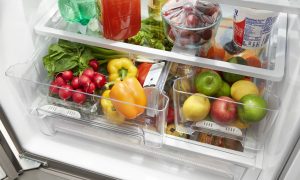1. The Temperature Control Setting is Incorrect
This is a common problem, the temperature control panel gets a bump when some food times are placed in or taken out of the refrigerator, and the temperature is changed. This is a very easy problem to fix, but many people forget to check this before they look at other possible causes. Check the temperature control panel and set it to a cooler setting and this may fix the problem.
2. Dusty Condenser Coils
The condenser coils are usually located at the rear or underneath the refrigerator. This is a critical component that regulates the internal temperature of the appliance. But, the location of the coil makes it vulnerable to the accumulation of dust and dirt. These contaminants will affect the performance of the refrigerator. This is an easy problem to solve, brush the dust from the condenser coils and the refrigerator performance will improve. You can even find a specially designed soft brush for this purpose and brushing the coils every 6 months is a great idea.
3. Faulty Door Gaskets
Gaskets are the rubber seals around the doors of the refrigerator and freezer. They are effective at keeping the cool air in the interior, but they will suffer from wear and tear over time. As they degrade and fail, they allow the warmer external air into the refrigerator, and the cooler air can escape. This lowers the internal temperature leading to premature food spoilage and a drop in energy efficiency. The gaskets should be checked for creaks and tears, or they may be loose in certain places around the door. If the door gaskets are compromised, they should be replaced by a repair specialist.
4. An Overloaded Refrigerator
If the refrigerator is overloaded, it can struggle to cool the interior efficiently. There needs to be airflow to cool the space, and crammed shelves prevent this. The air vent can be blocked by food items that exacerbate the problem, and the refrigerator will become warmer. To fix this problem, make sure that there is a ½” gap between food items and don’t let them touch the sides and rear of the refrigerator. The air vent should be kept clear, and any food that’s on the verge of spoiling should be eaten or thrown away.
5. The Refrigerator Location
If the refrigerator is placed in a location that’s too cold, it can shut off because the built-in thermometer is confused into believing that it’s already at the right temperature. If the location is too hot, the refrigerator has to work harder to compensate, and overworked equipment is more prone to failure.
5. The Motors are Not Working
The condenser fan motor circulates the cool air, and if the refrigerator or freezer is not cooling the interior, this could be the cause. If the freezer is working and the refrigerator is not cooling, then the problem may be the evaporator fan. These two fans are important components, and a technician is needed to fix them.
If your refrigerator is not performing correctly, it’s time to speak to a home appliance repair specialist; they can help you to get the maximum functionality and efficiency from your appliance.
